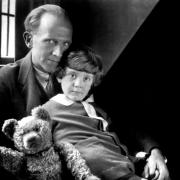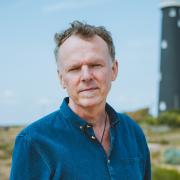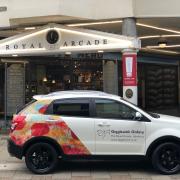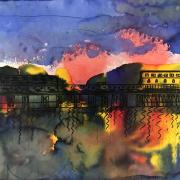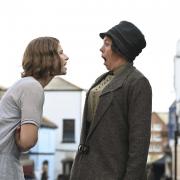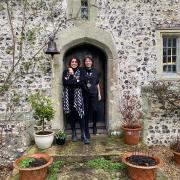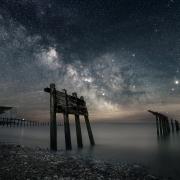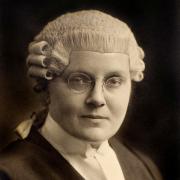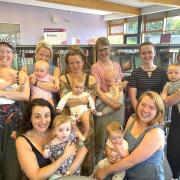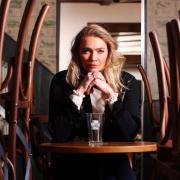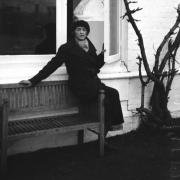For more than three decades painter Alan Rankle has called St Leonards home. As he donates one of his works to Chestnut Tree Hospice’s annual Big Heart Auction this summer he tells Duncan Hall about his ongoing environmental concerns and how his latest mixed media landscapes are trying to capture the feel and atmosphere of a city

From his third floor studio Alan Rankle has a view all across St Leonards, looking over the rooftops to the beach and newly restored pier beyond.
The rays bounce around his paint-spattered white walls recalling a classic Italian Renaissance studio – albeit one with shelves of CDs ranging from Bella Bartok to Captain Beefheart and handwritten quotations and phrases scrawled in permanent marker.
“The light reflected from the sea is extraordinary,” says Alan, 63, who works with assistant and fellow fine artist Rebecca Youssefi in the studio.
Alan’s latest projects include the exhibition Pastoral Collateral, which was at the Art Bermondsey Project Space in London’s Bermondsey Street until April.
Both he and Rebecca have contributed artworks to the Chestnut Tree Hospice Big Heart Auction which takes place in July.
Alan’s contribution is a limited edition inkjet print of a pastoral hillside landscape corrupted by bright blue and red brush strokes.
This sublime scenery, drawing inspiration from the likes of JMW Turner and Claude Lorrain and based on landscapes in West Yorkshire, Italy, New York and Scandinavia, is a recurring theme in Alan’s work. He alters and changes the pastoral scene with the addition of bright colour and most recently layers of texture built upon the canvas by Rebecca.
He describes her preparation of his canvases on their occasional collaborative works as almost being artworks in themselves. The shapes and textures recall wood grain or leaf prints, giving set space for Alan to work in, and emphasising certain aspects of the scene.
“I’m not so much trying to make a definitive version,” says Alan of his return to familiar landscapes.
“A lot of artists will do this – return to painting the same portrait, always feeling they can do another version. You can put them in different lights as Monet did with Rouen Cathedral.
“I can draw the trees from memory and reimagine them in another form. I relate it to the way musicians work on classic songs – when Bob Dylan plays an old song he is improvising on the memory of the song. I’m improvising on the memory of the painting. It would be interesting to get some of the series of paintings together from over the years to see the same view in different ways.”
His disruptions of the pastoral scenes come from a passionate interest in the environment, which began when he was part of the Friends of the Earth-supported Arts for the Earth in the early 1980s.
“Arts for the Earth wasn’t just about raising money, it was about raising issues,” he says, adding that in 1986 he received a lot of media attention for a 30m Chinese-inspired landscape scroll produced on Beachy Head with collaborator Jan Stephens.
“At that time people noticed forests were being destroyed in the north of Europe because Britain and Germany were putting out this sulphurous smoke from their factories. It’s illegal now – and Arts for the Earth was instrumental in that.
“I was also involved with the Marine Stewardship Council, trying to persuade governments around the world to create a sustainable ocean. They have had a lot of success.
“But now sadly governments are not responding fast enough to the environmental crisis. Tom Burke [former executive director of Friends of the Earth] has been a major supporter of my work. He says today it’s like they never made any progress. He got Putin to sign up to the Kyoto Agreement on greenhouse emissions, and then a few years later both the Russians and the US backed out.”
The historical element to his painting reflects another time when big money was making untold damage to the environment.
“The romantic landscapes were financed in Britain by people who had made fortunes out of the Industrial Revolution and the slave trade,” he says.
“These wonderful artworks were looking back at a golden age, and were sponsored by people who had ruined the life of the peasant in England forever.”
Alan initially brought his young family to St Leonards in 1983, preferring to bring them up by the sea rather than in London. Over the years he has seen the town change and develop.
“Lots of artists and musicians have moved here,” he says. “More recently there have been people working in television and film. There is a dialogue about art evolving which is very beneficial.”
When I arrive in his studio he is preparing to move temporarily over to another studio he keeps in a converted barn in the grounds of an old country house 60 km from Marseilles in France. “I also work in Copenhagen,” he says. “It’s nice to go from one place to another, doing the same work but in a different environment. Most artists I know are always travelling.”
Indeed his latest projects with Rebecca have had a psycho-geographical edge, as he explores cities for different commissions.
The pair recently put together a series of seven paintings, entitled Alluvione di Nero, for the JW Marriott Rose Island Resort and Spa in Venice.
The starting point for the images was a series of around 100 montages made by Rebecca from her photographs taken while walking and sailing around the city.
“She notices different things,” says Alan. “We are creating works that have many layers of art and photography – the photomontages underpin them. It’s another way of looking at the city.
“By mixing up two or three layers of photographs it creates a new narrative, and an image that no-one has ever seen before.”
Another element which has come into Alan’s work recently is graffiti tags – inspired by an experience with taggers in Copenhagen.
“I got annoyed with kids tagging my front door,” he says. “We were right between a skate park and a housing estate and nearly every day a group of kids would tag their names.
“Originally I was going to paint a butterfly on one of their tags – suggesting they learn how to do something like that. But instead I took photographs of their graffiti and printed it onto my canvas.
“When we had an exhibition in Copenhagen all these street kids came in to the private view pointing at the tags saying: ‘that’s mine!’.”
Details of The Big Heart Auction can be found online at www.bigheartauction.org.uk. Alan and Rebecca’s work will be on display ahead of the auction at St Marys in the Castle, in Pelham Crescent, Hastings, from 21 to 23 June.




